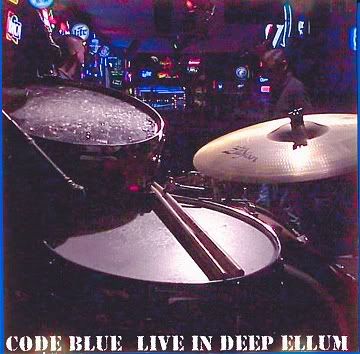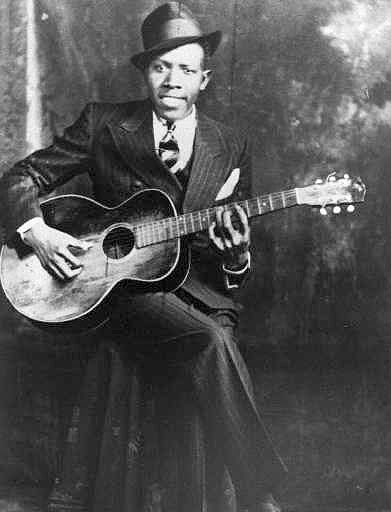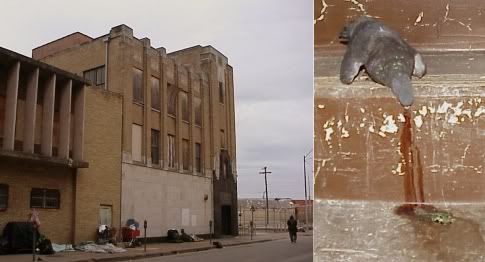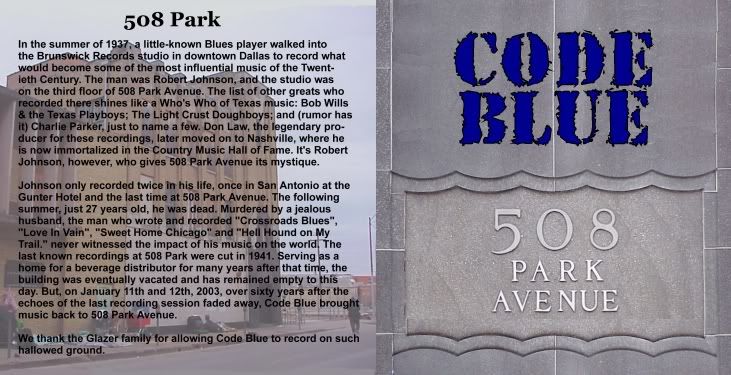I just received a 16Gb memory chip for the GPS/mp3 player I'll be taking on the trip. I needed to upgrade from the 8Gb chip I had previously installed because I have so many tunes and a small library of audio books stored that I actually ran out of memory. While I was transferring all the data from one chip to the other, I began adding music from my media storage drive that wouldn't fit on the smaller chip. In doing so, I started listening to some tunes I haven't heard in years. One of the folders I copied over was a collection of tunes from my old band Code Blue. I hadn't listened to any of our stuff in a few years and when I did, it really took me back. While this series of entries is barely relevant to the Alaskapade, it satiates a need I've felt for a while to document what were some pretty cool years in my life. I suspect it will take me a few entries to wrap my head around all the memories and document them. I won't let these entries interfere with the true purpose of this blog. Nevertheless, if non-Alaska related material bores you, stop reading here.
 |
| L to R: Jim Ken, Stu, me & Steve |
Code Blue came together in 2001 when my best friend (the prom photo friend) and I decided to quit talking about someday playing music together and actually did it. He and I used to sit around in high school and draw album covers talking about how we would someday tour the world and elsewhere. Stu played bass and I was a drummer. We managed to jam together a couple of times while I was in the Air Force, but he was a teacher up in Dallas and I lived in Austin so there was never any real collaboration. I played in bands down there and he had projects up here. When I exited the service, it took me a few years (eleven to be exact) to get my career together to a point where I had enough free time to pursue music and commit to a band. I ran a Craigslist ad and had numerous responses right away. One of those responses was from a singer/guitarist named Jim who brought a guitarist along for a casual jam session with Stu and I. The guitarist (Steve) was a weird little dude, but he had good gear and the guy could really play. Jim was a pretty good singer, but his ego was larger than his balding forehead. I was weird also and so was Stu, so what the hell? We cranked out a few electric blues tunes and instantly had a tight sound and a rapport that seemed to click. We decided to select a few more tunes and get together again the next week to see if that excitement was genuine or fleeting. As we parted ways, I mentioned that my friend Ken played keyboards and offered to ask him over for the next session. Ken was an excellent singer, keyboardist, rhythm and lead guitarist, and drummer. Recognizing Jim's ego, I kept Ken's additional talents to myself for the time being. Ken joined us the following week and things really clicked. Those early jam sessions were instrumental (no pun intended) to the band's future success because jamming instantly identifies the presence or lack of musical chemistry among the musicians. Within a few weeks, we had a nice repertoire of tunes and the neighbors who heard us playing were always complimentary. It seemed we were on to something and it was time to play in front of a crowd. We needed a name. I don't recall who came up with Code Blue, but we all liked it and the name fit well with slogans like "Blues that take your breath away" and "The blues never hurt so good".
 |
| First Gig - "Woodstock" in North Texas |
Not many bands have the luxury of having their first gig compared to Woodstock. Ours was, but only in that Woodstock was also held in a cow pasture. We drove a hundred miles to play a dirt motorcycle event held in the middle of nowhere. We set up on a large flatbed trailer and powered our instruments and amplifiers with portable generators. The weather was great and the crowd of about 200 people seemed genuinely appreciative. I was especially nervous for a number of reasons. I hadn't performed in front of a crowd in twelve years and this crowd was comprised of many of my friends. I was one of the organizers of the motorcycle event, so my reputation was on the line on many levels. All the tunes were covers, but our renditions of some of them were pretty unique and some of the tunes were so obscure that many in the crowd might have assumed they were originals. We finished the gig and knew without question that we indeed had the makings of a decent band. We just needed time, more tunes, and gigs.
Our second gig was in downtown Dallas on Mother's Day at an event that was sponsored by a local radio station. Dallas has a ritzy area called the Swiss Avenue District with enormous old homes that are worth millions. Each year, the Swiss Avenue Tour of Homes is held on Mother's Day and is centered around a park in the middle of the district. The tour is an opportunity for the common people to wander through the rich peoples' homes and admire their stuff. I never really grasped what enticed the visitors, but I was glad they were there because they made for a large audience and we were right in the middle of the action. I did wonder however, if people who were interested in fancy Tudor homes would be interested in the music we were bringing.
This was an easy gig because we didn't have to bring any PA gear. All we had to do was show up, play, and be good. The event and our band name were advertised heavily in Dallas area television, radio, and print media in the days preceding the event. and all of our friend sand families came out to see us. No pressure! There were a few opening acts on stage before us and we made it a point to get there early enough to see them and size up or competition. We missed the first act entirely, but apparently everyone else did too because there was no crowd gathered as they were unloading from the stage. The next act was a quartet of little old ladies who called themselves Flute Salad. Seriously. They each sat up on the stage in chairs and their music stands were draped with miniature quilts adorned with their names and cutesy little pictures of flutes. The five of us stood looking at the quartet in their full-length dresses and then at each other in our sleeveless black rock and roll t-shirts. Well, all of us except Ken. Ken was older than the rest of us (around 60) and was sporting a collared golf shirt, Bermuda shorts, loafers, and tall white socks.
The next act was a solo vocalist named Angie Streck. Angie sang to a CD soundtrack and was excellent. She captured the crowd and sang her heart out. I sat at a table near the back and just listened. She looked as good as she sounded. I commented to the one other guy at the table that her voice was as hot as she was. He just nodded. After her performance, I went to say hi to her as the crew prepared the stage for our gear. I told her how much I enjoyed her act and we chatted a moment. Then she introduced me to her husband; the same guy who was sitting at the table with me moments before. I was sure glad I included her vocal talent in my description of her when I spoke to him.
 |
| Code Blue @ Swiss Avenue (Notice Ken's Socks) |
Code Blue were up next. We set up our gear and did a quick sound check. I stood at the front of the stage before we went on and noticed a big sign the radio station had printed that read "Code Blue - Smokin' Eclectic Blues". It was supposed to say "Smokin' Electric Blues". As I read it, I wondered if it was an error or a judgment call based on the previous acts. It was too late to care. I hopped on stage and we kicked off our set with our arrangement of "Turn It Up", a mild, bluesy number littered with smooth guitars and old school Hammond keyboard sounds. The moderate-sized crowd applauded politely. The tempo of our set ratcheted up sharply with a tune called "Big Leg Woman" during which a much larger crowd gathered and applauded more enthusiastically. By our last tune, "Superstition" we had a huge crowd which we figured were the people who were dragged out to the event, but had no interest in touring the houses. This was no Stevie Wonder rendition of "Superstition". Ours was more like George Clinton and Parliament Funkadelic meets Metallica and it ended with Steve's whammy bar guitar wailing feedback echoing off the houses across the park. The crowd of previously subdued suburbanites went crazy as the guitar squeal faded. There were plenty of onlookers who were just confused by what they heard as the others were enthusiastic, but the majority of people there got it and we were stoked. I'm not sure what the ladies of Flute Salad thought of our set. We killed despite the absence of a gimmick like custom quilts. Maybe it was Ken's socks that bridged the generation gap. We left that event having been offered (and accepted) two club gigs on the spot.
 |
| Legendary Hole in the Wall |
 |
| Cover Looks Cooler in Person |
As the months went by, our set list grew, our fan base grew, and our tightness as a band grew. However, nothing grew as fast and as large as Jim's ego. We had established ourselves as a tight, rocking blues band with a reputation for bringing a crowd to the venues we played. We played all the Dallas club districts; Deep Ellum, Lower Greenville Avenue, and branched out to suburban gigs, city festivals, and private parties. As the band's primary booking contact, I was always scheming for ways to distinguish Code Blue from other bands. When a print publication listed us on their agenda, I would clip and copy that ad and include it in our booking packet. when the booking agent listened to our demo CD, they would see all the venues we played. If I couldn't get us into a club, I'd book us next door and remind the other place who we were when we filled the place up. We had t-shirts made emblazoned with our logo and gave them to our real fans who always showed up. We sold the rest for a 100% profit at $10 each. T-shirt revenue was sometimes more than the gigs themselves paid. We did a live radio broadcast show from a club in Dallas one night from which we cut a short five-track CD "Code Blue - Live in Deep Ellum". I shot the album cover from behind my drums and to this day, I think it's one of the coolest covers I've seen. We used that CD for promotions and gave it away with the t-shirts we sold. We returned to that same venue and had a tongue in cheek celebration of our Live CD going "tin".
We had our share of dead venues. We worked one club where literally the only person in front of the stage was the janitor sweeping the floor as we played. It was the dead of winter and Dallas had just had one of its infamous ice storms. The building had a power outage and tapped electricity from the building next door. Our gear barely functioned and there was no stage lighting or heat. They didn't even bother to open the bar and probably wouldn't have opened the doors had we not shown up. Nothing puts your ego in check like playing to a janitor in a dark hall while your teeth are chattering. Every note of every tune seems to pass like a snail crawling through salt and all I wanted was for the gig to be over.
We played many venues that had no door cover charge. Always looking for a marketing angle, I would place a printable Code Blue logo on our web page's performance schedule with instructions to print and bring to the venue for free admission. They would have gotten in free anyway, but when the venue had multiple acts, it always impressed the management when there was a pile of Code Blue pages at the front door. One club owner brought a pile of them to me as we were loading out after a gig and asked me what I wanted to do with them. I replied "use them to remember who brought the crowd." Those pages and the crowd of Code Blue t-shirts always sent a clear message to club management. We were the headline band at our next gig there. The bigger the crowds, the bigger the paychecks, and the bigger Jim's ego grew.
After a couple of years, we had a large catalog of original tunes and a new lead guitarist named Dennis. Dennis was an accomplished player and a great songwriter. Between Dennis, Jim, Ken, and Stu, we had some serious musical creativity. As the drummer, I had no real musical skills. All I could do was count to four. I just did it very steadily. My contribution was musical structure and dynamics, especially in our performances. Any band could play the middle of a tune. The transitions from tune to tune, starts and stops, and key modulation were all elements that few people in the crowd understood, but knew instantly when they were lacking or inappropriate. People kept asking where they could buy the tunes we played. People actually still bought music back then. We decided it was time to cut a real CD.
 |
| Robert Johnson (circa 1936) |
As egotistical as Jim was, the man had connections. Stu had pointed out to the band that there was a musically significant and historic location right in downtown Dallas which was all but forgotten. The dilapidated building at 508 Park Avenue had once been a film distribution center for the Elm Street theater district. Elm Street was revitalized as a club district in the 80s and became known as Deep Ellum. The 508 Park building had the distinguished history of being the last place that Robert Johnson (the father of delta blues) recorded his music back in 1937. Stu had the brainstorm idea to try to get into 508 Park to record our CD of original tunes. Jim's connections paid off and we secured access building - for one day.
The wheels were in motion. We found a recording engineer, picked ten tunes to record, and cleared our schedules for a marathon overnight recording session. We loaded our gear into the building which was in major disrepair. The place had electricity because it was for sale and prospective buyers might need it. But, it had no plumbing, heat or air conditioning, and most of the windows were either broken or boarded up. None of this would have really mattered had it not been January and Dallas was in the grip of freezing rain. 508 Park was directly across the street from The Stew Pot; a church ran kitchen that fed the homeless. As such, every square inch of sidewalk anywhere near our building was lined with homeless people sleeping under whatever they could find to shield themselves from the rain and cold. We were a blues band and if the scene outside didn't inspire us to make a good record, I can't imagine what would.
 |
| 508 Park - Outside & In |
We started loading in early in the morning and wound our gear up the street past the indigent sprawled out around us. Occasionally, someone would ask who we were and I one even asked for my autograph...and any spare change I might have. We were recording by noon and continued through the cold, rainy night. At one point, an editor and photographer from Southwest Blues magazine showed up to document the event for what would eventually become a pretty cool cover story. Word of what we were doing had spread among the Dallas blues scene and thus the pressure was on for us to deliver musical justice to the legacy of the building. Hash Brown notwithstanding, the Dallas blues scene could be pretty cut throat and we heard rumblings of "why them" when the story got out. Why not us? We thought of it and we seized the opportunity.
 |
| Bright-Eyed & Bushy Tailed (Before the Sessions) |
After countless takes, arguments, curse words and even a few tears, we emerged from 508 Park Avenue in the morning daylight with blurry eyes, hoarse voices, sore limbs, and ten original tunes. It didn't take us long to come up with a name for the CD. Since the other guys had the writing credits, I took on the artwork and production responsibilities. I ponied up the cash to have 1,000 copies pressed with the clear understanding that any and all band proceeds came to me first until my investment was repaid. We had a CD. Now what do we do?
 |
| 508 Park CD Cover Art & Fold Out |
 | ||
| Rear Cover |
 |
| CD Insert Art |